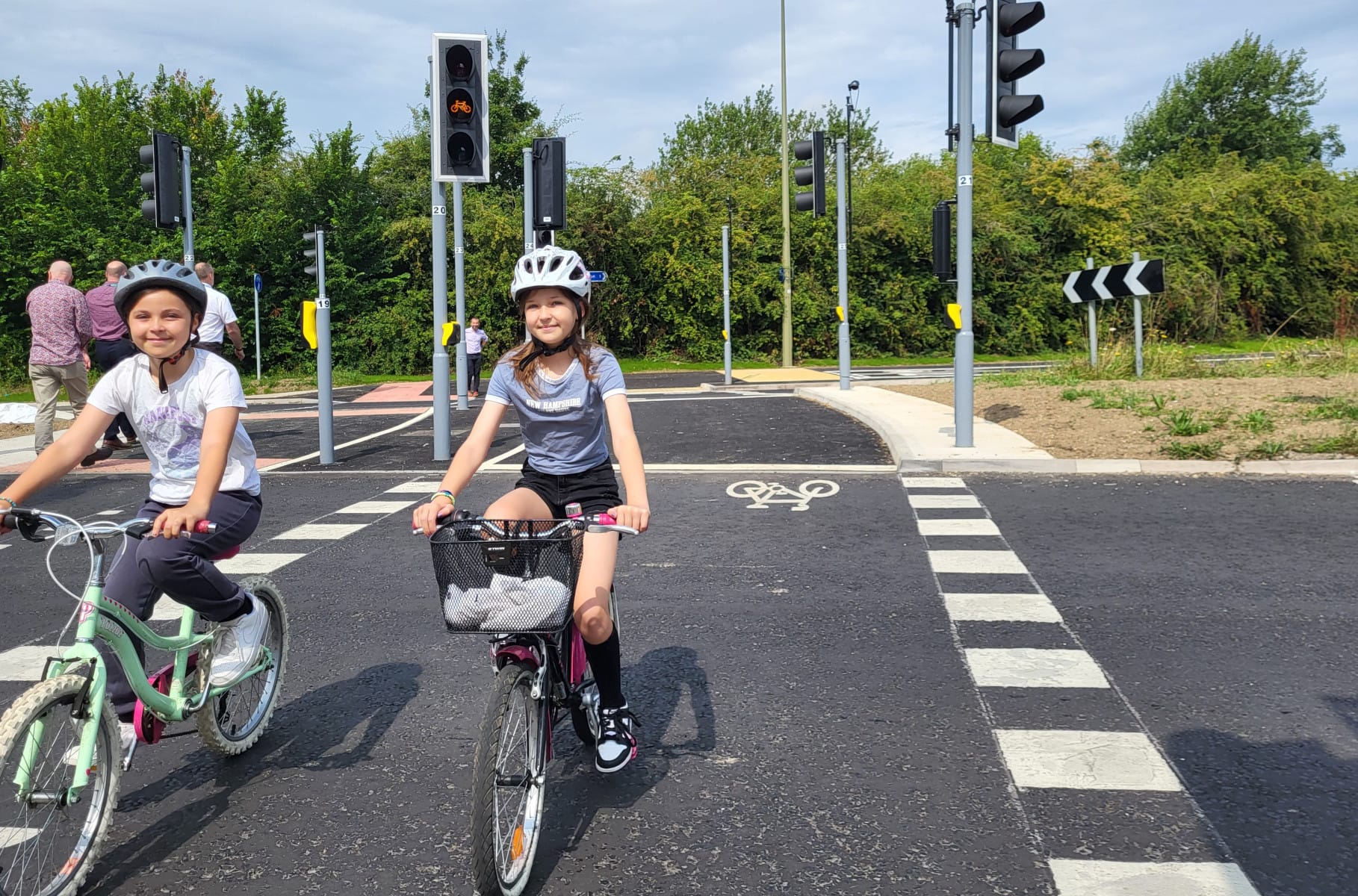Oxford’s traffic problem: the big picture

No issue in Oxfordshire is more fiercely contested than Oxford’s traffic. Most people agree it’s a problem – but not how to fix it.
Oxfordshire County Council, which is responsible for roads across city and county, is trying to reshape Oxford’s traffic through a series of interventions – Low Traffic Neighbourhoods, traffic filters, a Zero Emissions Zone, a Workplace Parking Levy.
You have no doubt heard these buzzwords countless times already. But the reasons why the council is proposing these are often lost in the cut and thrust of daily debate, the endless stream of headlines focusing on the controversy of the day. We decided to take a step back and ask what the proposals are intended to achieve, in a longer article rather than a daily news bite.
Andrew Gant is the Liberal Democrat member of Oxfordshire County Council’s cabinet currently responsible for transport management – as such, the politician most closely associated with OCC’s plans. We asked him for a “big picture” overview of the changes, and the difficulties encountered along the way.
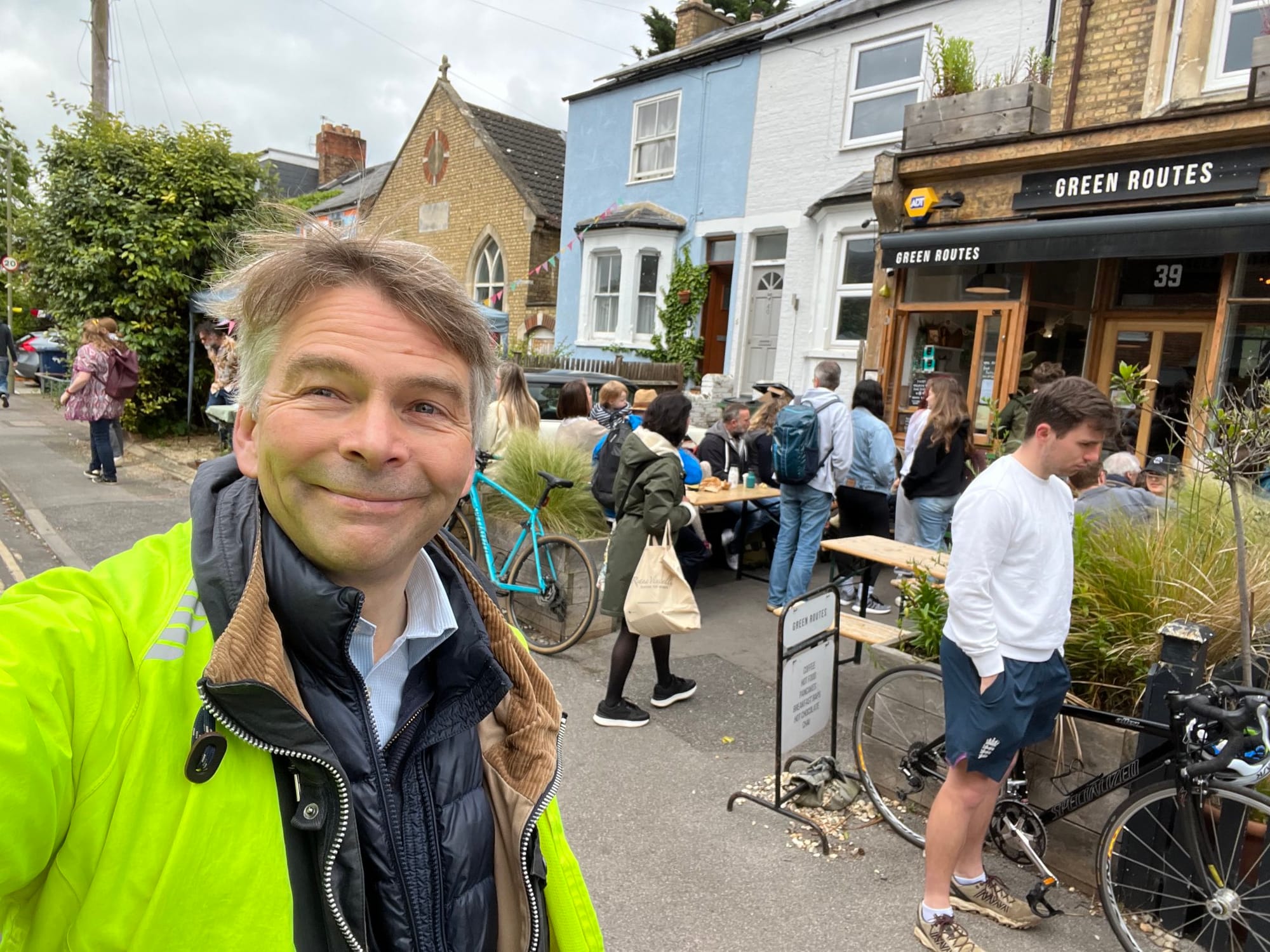
Explain to us why Oxford’s traffic is so bad.
Oxford has a problem. It’s certainly not unique to Oxford, but it affects all of us.
The problem is quite simple. We live in a medieval city, with largely Victorian and early 20th-century suburbs, and our streets are being asked to cope with levels and types of traffic which they were never designed for. They are full. About 100,000 new houses are being built across the County, many around Oxford. The population of Oxfordshire is predicted to rise by 15% this decade.
We can manage this growth but only if we have a plan. We can move many more people around in tight spaces if lots of them are on buses, bikes and on foot – but we simply cannot provide reliable buses and safe streets if everyone drives, all at the same time, to the same places. Continuing growth in car traffic, when alternatives exist, has consequences for all of us – in terms of safety, the economy, educational attainment, recruitment and retention of staff, access to services, climate, the air we all breathe, our physical and mental health, and the vibrancy and attractiveness of our public spaces. Divinity Road used to have 6,000 cars going up and down it every day. Now it doesn’t. Our policies have reclaimed it for residents.
What has been proposed in the past to fix this?
Planners used to think we should predict increases in car use and build more roads to cope. Fortunately, we don’t think that any more, because it doesn’t work: however much new road space you build, it will always just fill up (look at Los Angeles).
There used to be serious plans to build a road across Christ Church Meadow, and another across Port Meadow from North Oxford to Botley Road, to relieve pressure on the city centre. I don’t think anybody would support such proposals today.
Our approach now is to work out what kind of community we want our children to grow up in and be bold enough to make it a reality. If we actively choose policies which we know will make buses reliable and fast, and make cycling safer and more pleasant, people will have genuine non-car options. It’ll take time and adjustment, it won’t always be easy, but it’s long-term thinking – solving the problem at the root, not sticking our head in the sand.
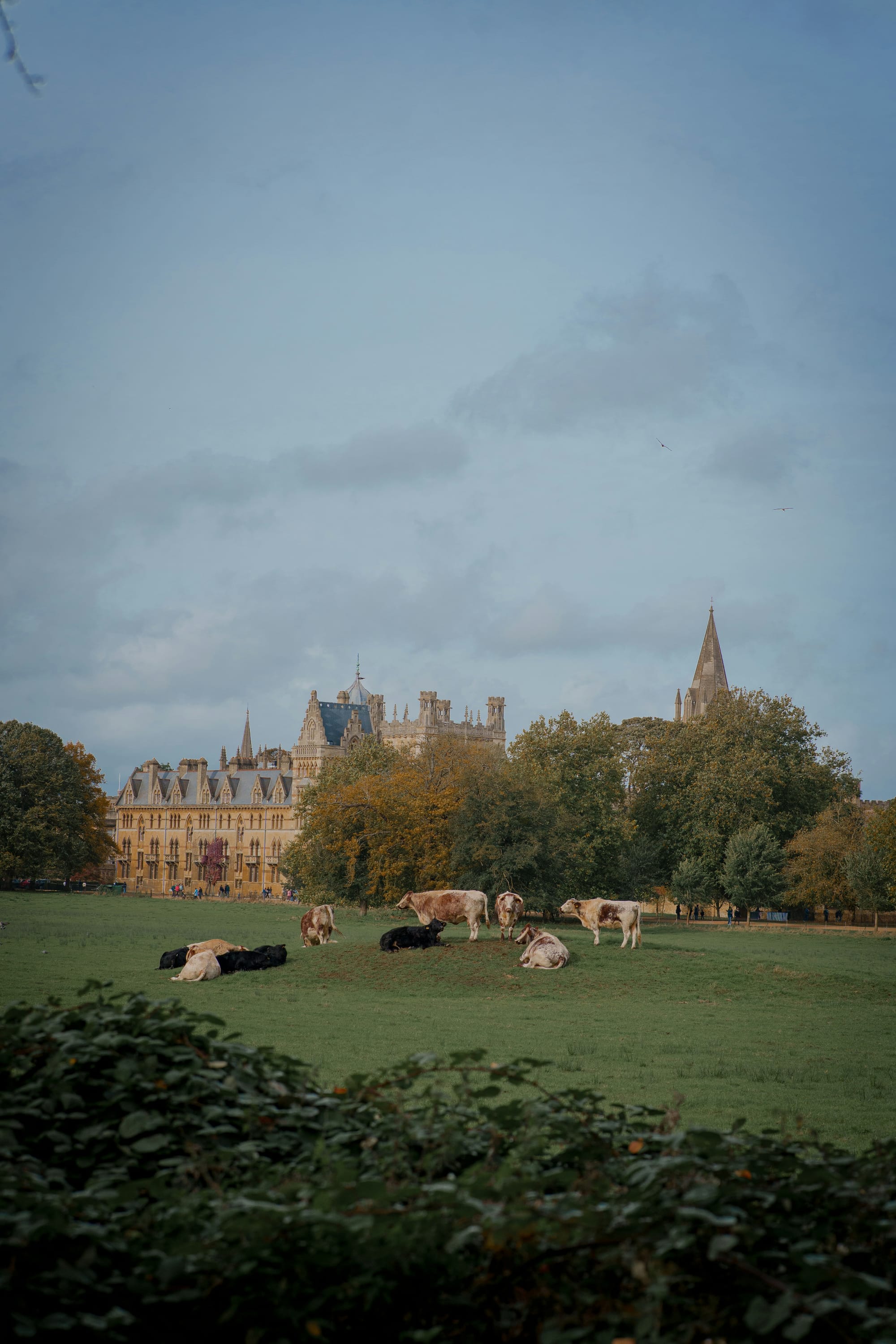
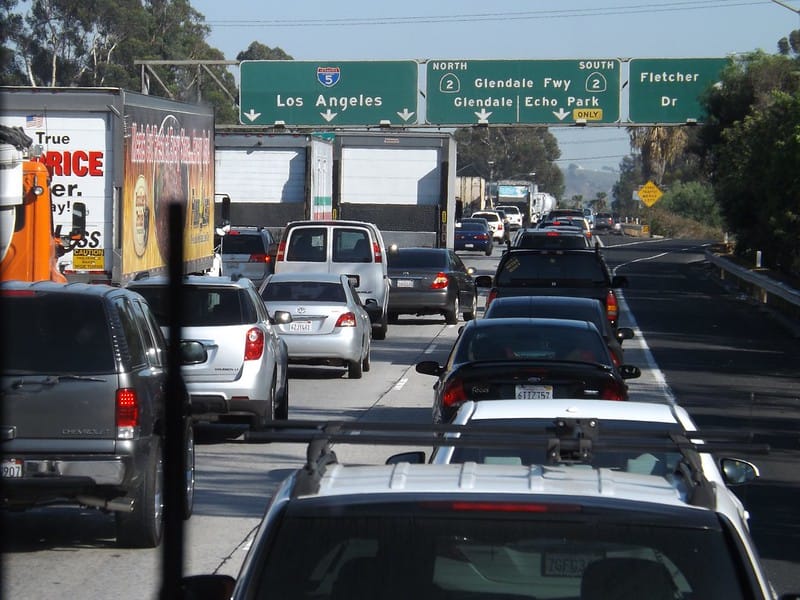
Christ Church Meadow (Unsplash, Benjamin Elliott). Los Angeles traffic (Flickr Young Shanahan, CC-BY 2.0).
So what is the council’s plan?
Our vision is based on making the best use of the limited space we have, and getting each type of road to perform best for the people who use it: residential and urban streets are for people; for neighbours to chat, kids to scoot to school, quiet, clean air streets.
Trunk roads, ring roads and radial routes are for getting around – buses moving large numbers of people, our vibrant business economy functioning, space for those who really need to drive to do so. Today, new residential developments are built that way by default. Residents can still perfectly easily drive to their homes, get deliveries, and pick up elderly neighbours in their car. The school gate is freed from the blight and danger of cars and becomes a place to meet and talk. I want all communities to have those benefits.
The County Council is bringing forward a range of policies around this sensible approach. They’re practical, they’ve been tried and tested, and they work. There are many, many streets in Oxford which have been adapted over decades to remove through traffic, including Cornmarket, Holywell Street, Kingston Road, Osney Lane, Fox Crescent and many others. Nobody would dream of reversing those changes now. Cambridge has had its inner bus gates for decades; my home town of Reading successfully pedestrianised the central area years ago; Nottingham paid for their brilliant tram system with their workplace parking levy.
Providing good alternatives is key: if parents feel it is safe for their kids to walk and cycle to school because there’s a well-designed route then parents will let them do it. That improves students’ health, mental and physical well-being, social opportunities and educational attainment. What teenager wants to be stuck in a traffic jam when they could be chatting to friends on the way to the bus-stop, kicking a ball about or getting about by themselves and learning to be independent? That in turn takes congestion away from the streets around schools, which creates a safer and cleaner environment and allows public transport, active travel and dedicated school buses to move more freely and safely. It’s a virtuous circle, which improves children’s lives. Who would not want that?
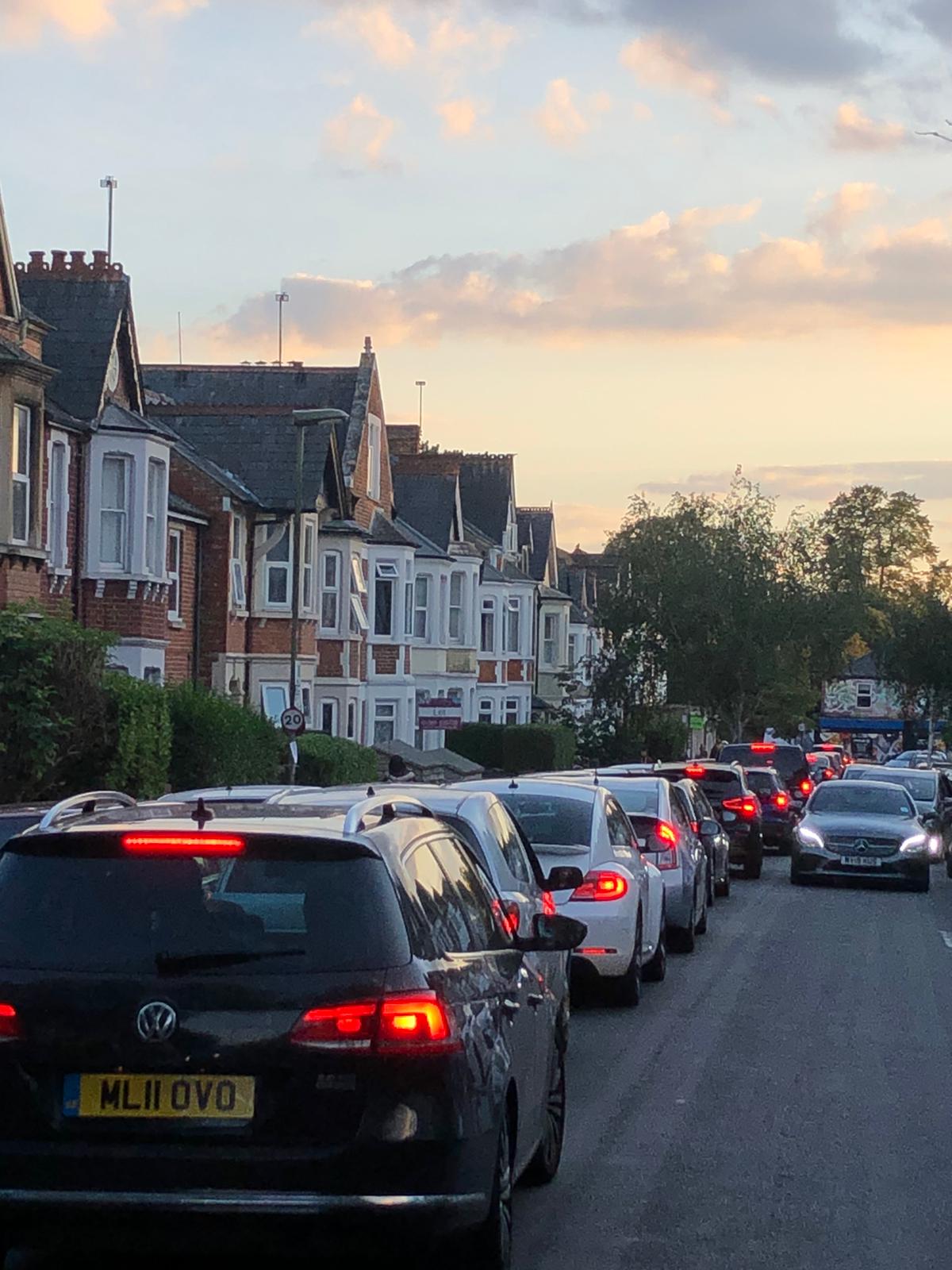
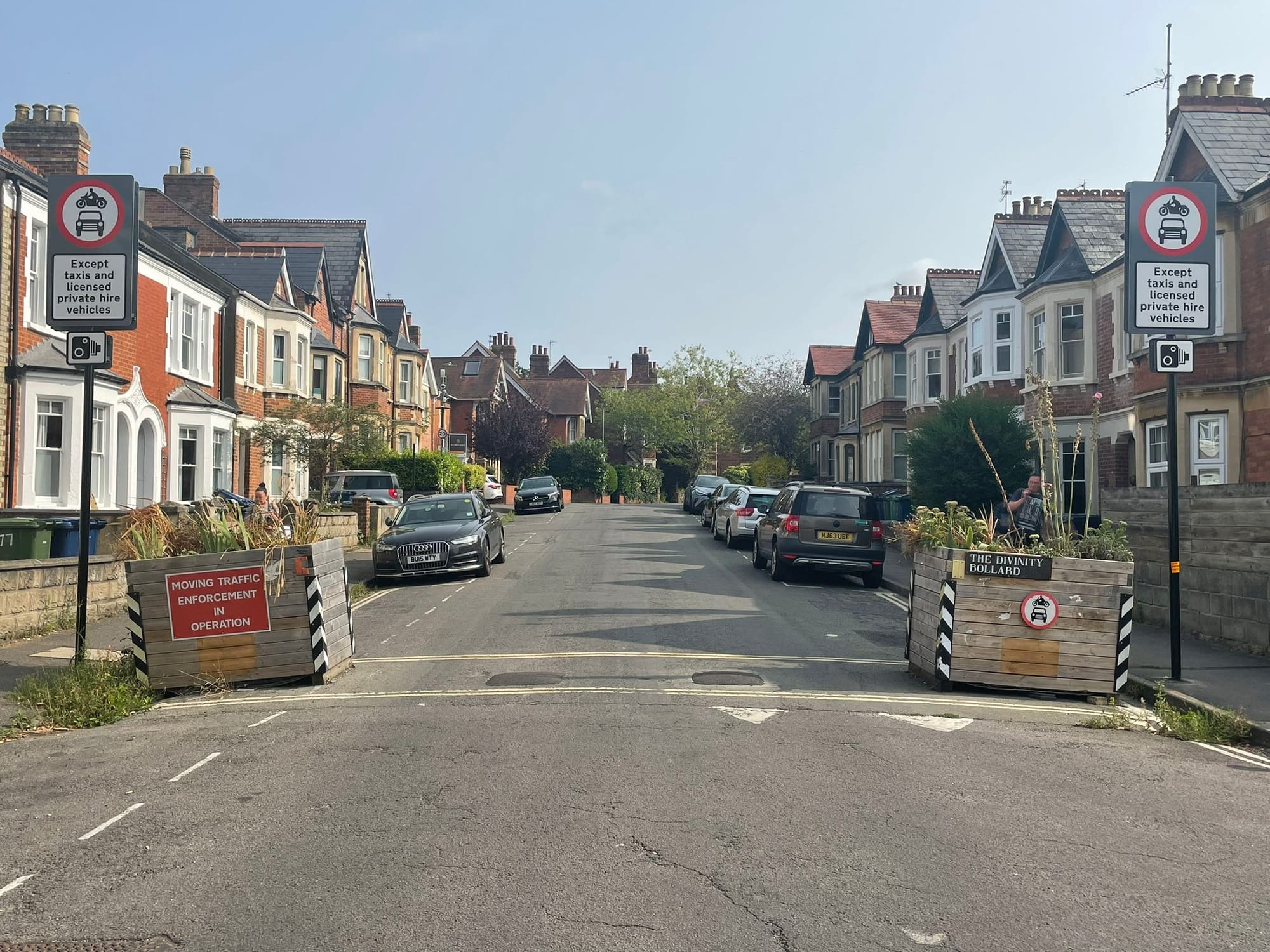
Divinity Road – before and after. (Photos: Cllr Jemima Hunt; Oxford Clarion.)
Explain the relationship between the Low Traffic Neighbourhoods, electric buses, and the traffic filters.
There are a number of policies, different but linked, in our approach. All political parties have promoted and supported these policies over the years, because all serious thinkers recognise that there are only a certain number of cars which can sensibly fit onto our roads at any one time.
Many recent LTNs [Low Traffic Neighbourhoods] were introduced by the Conservatives nationally. Oxford’s LTNs were a Labour idea, introduced by the last Conservative administration in this County. They aimed to change travel behaviour in key residential areas. They were right to do that, and I commend them for it. My role has been to safeguard those benefits, help the schemes bed in, and get them right as they become a permanent feature of our city. I’m delighted to have been able to do that. More residential areas continue to ask to be included.
The traffic filters scheme is based on the simple idea of asking some traffic which currently drives through the city centre to take an alternative route (which is, after all, what a ring road is for), or use different modes of travel. Roads are open, and as with LTNs, there is nowhere which you can currently drive to which you will not be able to continue to drive to.
The filters will speed up the buses and make them more reliable, they’ll mean we have two new bus routes connecting the eastern part of the city – from Blackbird Leys to the JR and from Pear Tree to Temple Cowley – with more improvements to bus services to follow. Key radial routes such as Abingdon Road will become a lot clearer, making Park & Ride a brilliantly quick option to get into town. Having a long-term solution to congestion will help, not hinder, people who work in the city, and the many, many people who commute in from surrounding areas and keep Oxford running.
I do understand that change causes nervousness. I have had more conversations than I can count which begin with residents expressing anxiety, even hostility, about what they think the impact will be for their own lives. When I explain the detail of operation, including permits, exemptions, hours of use and other aspects, worry turns to reassurance and fears are assuaged. A huge amount of care and thought has gone into this scheme. We and our partners are working hard to communicate the objectives and the detail clearly, and we will continue to do that.
The decision to put in the filters led directly to a multi-million pound investment by the County Council, the bus companies and central government in our new electric buses. I’m so thrilled to see these beautiful vehicles gliding noiselessly around our city (and to see the back of the noisy, dirty, smelly diesels they are replacing), and I’m committed to help them run to more places more quickly and more often. They are making the air we all breathe significantly better, and they wouldn’t be here without the traffic filters scheme.
Network Rail’s work on the Botley Road bridge has delayed the filters. But it doesn’t change the fundamentals. We will implement them as soon as we can.
The filters will require all of us to think about how we use our cars. 40% of journeys are under two miles: do you really need to drive for that journey? Could you try another way? Does your convenience trump the needs of others around you? Is your car actually the most convenient choice?
A car is a big, fast, intimidating, dangerous piece of kit. It makes me angry and sad to see drivers parking in bike lanes used by schoolchildren, or on crossings provided to help the elderly, partially-sighted, wheelchair users and parents with pushchairs, just to save themselves a few seconds as they nip into Starbucks or Sainsbury’s, when there is lots of safe, decent parking laid on for them just a minute or two’s walk away. We shouldn’t have to engineer in costly measures to stop people doing this: but if we do have to, we will.
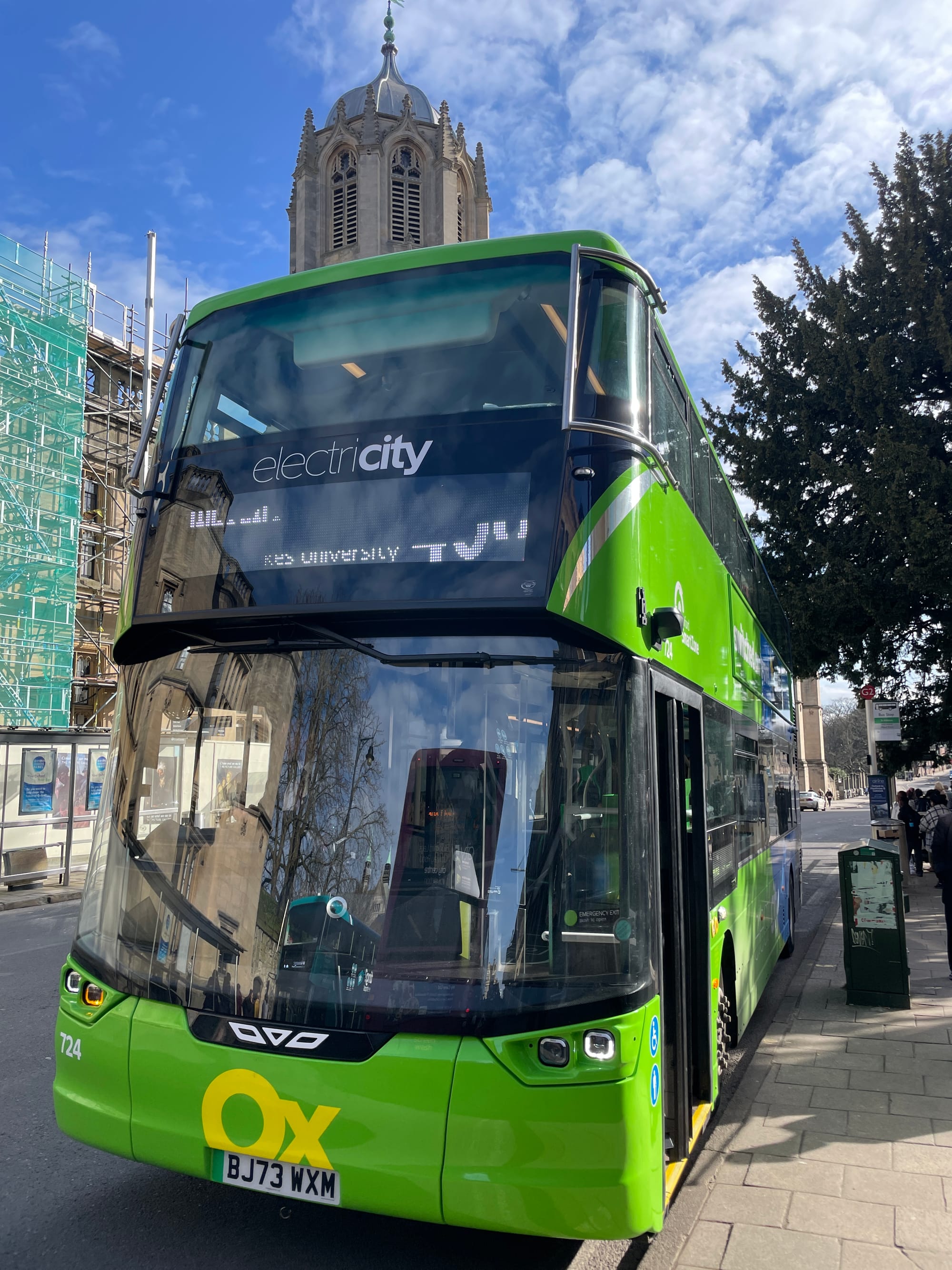
What is your ultimate vision for Oxford?
Picture Oxford with buses that turn up on time, excellent Park & Ride services and safe cycling options for those who would like to try that. E-bikes bring more locations within commuting distance. This will provide more options for getting to work at our schools and hospitals so that local roads don’t grind to a halt, while safeguarding the travel needs of patients, disabled people, health workers and carers.
Imagine the hugely successful pedestrianisation of Broad Street extended to more of our historic spaces; a much improved Christmas market and other events; tourist buses taken out of St Giles and residential streets; bus stops and routes planned holistically to deliver better connectivity and ticketing on our smart, new, all-electric, emission-free buses; better provision for cycling and walking, with barriers like crossing busy roads mitigated or removed; better, safer spaces for the elderly, wheelchair users, parents with buggies, our partially-sighted residents and blue badge holders; more choices including e-bikes and scooters for hire; traffic flowing freely, at safe speeds, because there is less of it producing far less pollution; a better station offering better services and a pleasant walk into the city; the ghastly Botley Road underpass replaced with safe, modern, well-lit cycle and footpaths off the road; a better offer for tourists; deliveries made safely and sustainably; kids doing better at school and living longer because they begin and end their day with healthy travel choices; and more greenery and much improved public spaces (we have some of the finest urban townscapes in the world, for sure; but much of our city centre still needs so much improvement). All of this is happening now.
Transport policy is not just about things with wheels. All policy is health policy. Kids who cycle to school get better grades. Greening the city doesn’t just make it look pretty, it protects us from climate change, improves our mental health and enhances biodiversity. And I’m particularly proud that a thread running through all this is that the needs of our most vulnerable residents are enshrined and safeguarded in our policy: when we pedestrianised Broad Street (what other historic European city would use one of its most iconic streetscapes as a car park? Oxford did until we changed it), the number of disabled parking spaces went up.
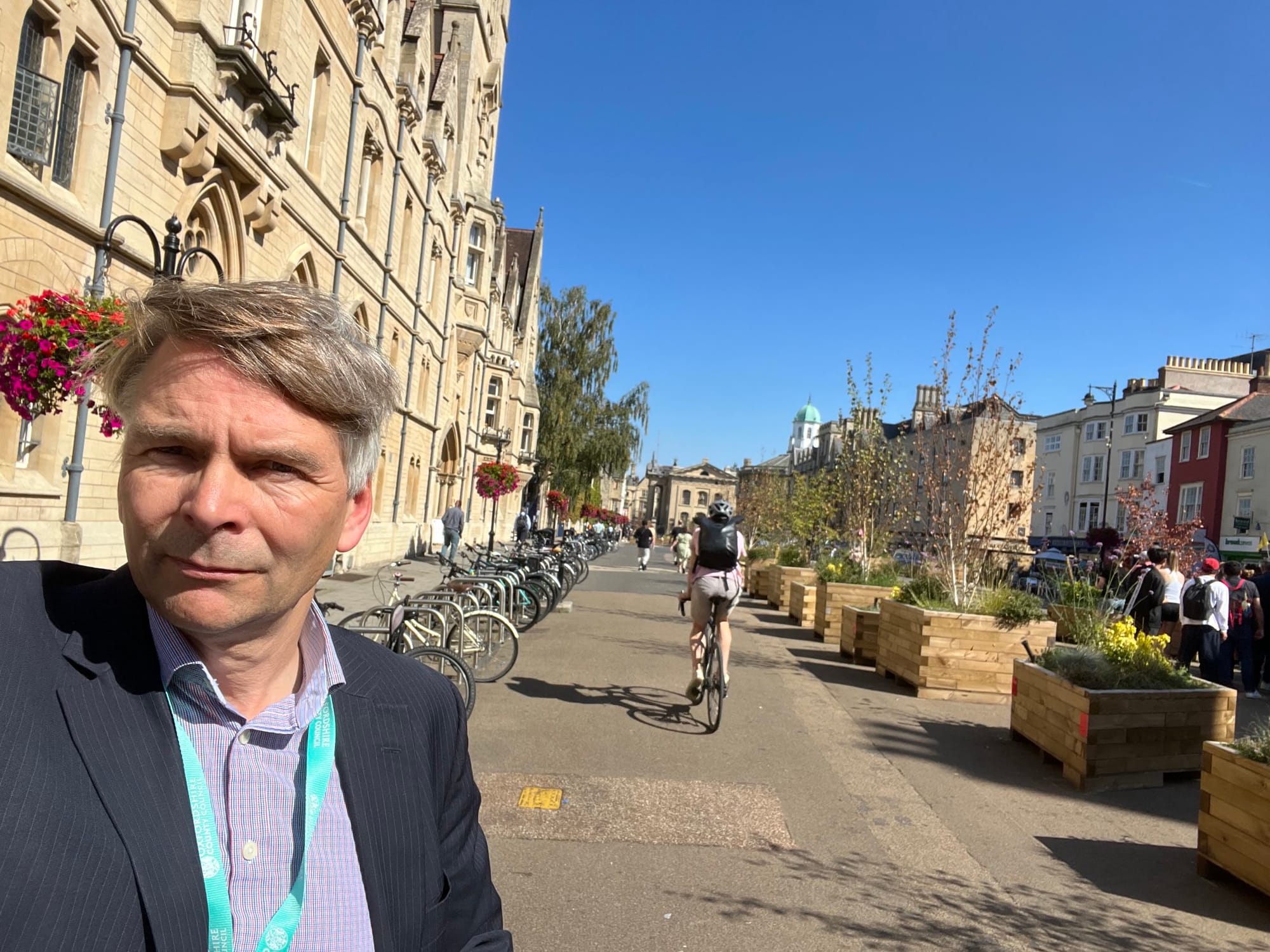
And Oxfordshire?
Oxfordshire is a big, diverse, largely rural county with a wide variety of types of communities and settlements. Of course, travel looks different if you live in a remote village compared to a larger town with good connectivity. Mobility hubs are a key part of our vision – places where you can park your car or bike and continue your journey via a choice of safe, reliable alternatives to the stress of driving.
Our Park & Rides have been a big success, notably the affordable combined ticket offer: we will continue to extend the Park and Ride concept, rolling it out further across the county. Our partnership working with bus companies and central government on things like reduced youth fares and seasonal discounts has been extremely popular, and we will look for more opportunities. Over 85% of communities in Oxfordshire have taken up our offer to reduce speed limits and improve safety.
We want investment in rail, including investigating reopening Grove station, improving the Cotswold line, completing East-West Rail to Bedford and on to Cambridge, improving tired facilities like Banbury station, looking at new stations at for example Begbroke, and making all our stations function as genuine transport hubs. We recognise and support the need for major redevelopment at Oxford railway station to deliver a step-change in the delivery of more passenger and rail freight services across Oxfordshire, and are enthusiastic for a phased programme of rail electrification.
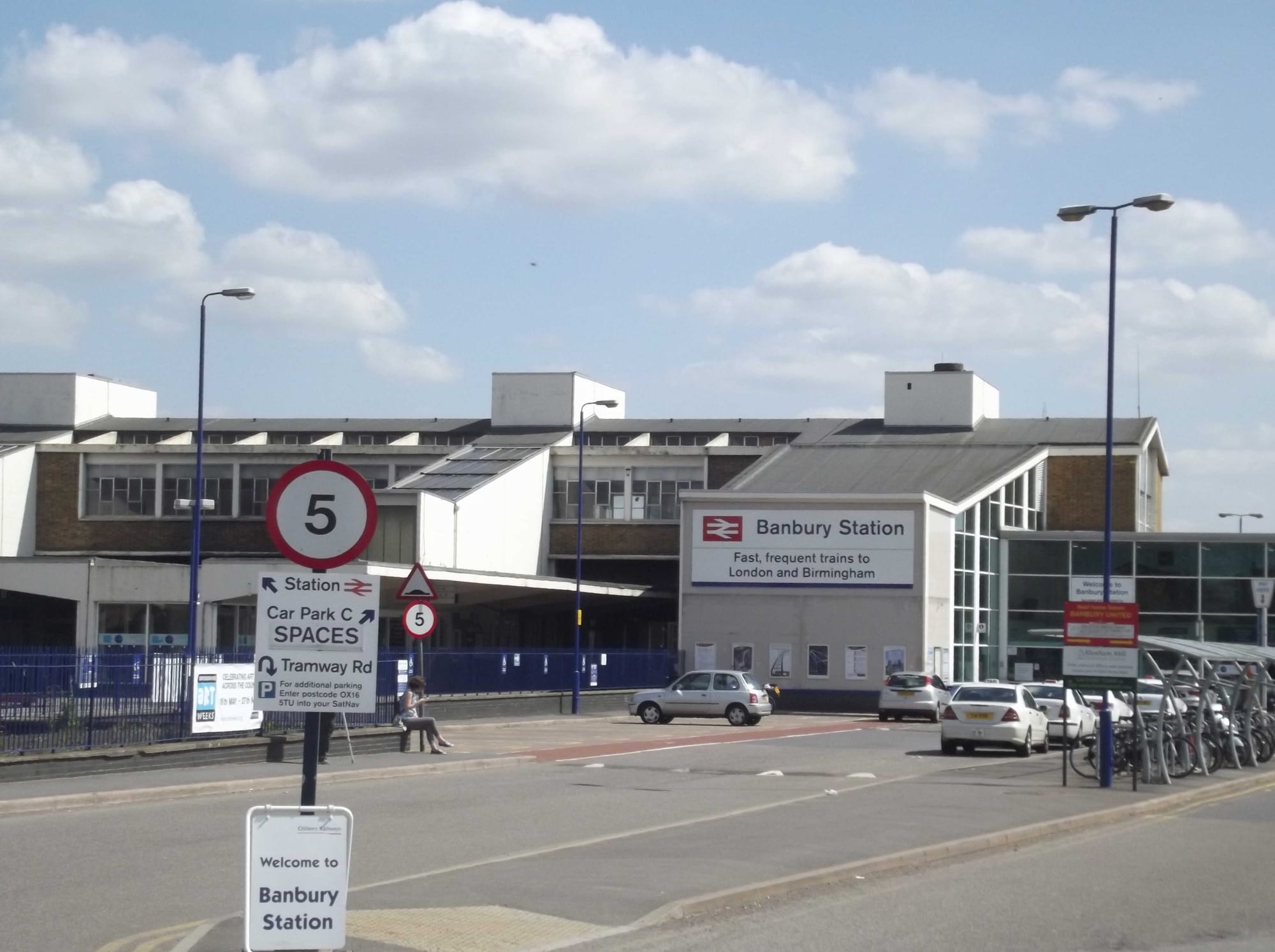
What are the barriers to this?
A point which often gets overlooked is that a lot of what we do is affected by factors outside our control, including the weather, the law, external agencies like utility companies, how and when government funds things and when an old bridge decides to start crumbling into the Thames (this happens a lot). The repeated delays to Network Rail’s Botley Road project and the knock-on effects for the traffic filters are a frustrating recent example.
Things often look simpler from the outside: people sometimes call for things to happen differently, or in a different order, when there are very good legal, financial or technical reasons why they can’t. Politicians do this (maybe deliberately; at other times because they haven’t done their homework).
Political consistency is a must: politicians who flip-flop when decisions get difficult just end up achieving nothing except generating hot air. We’ve seen far too much of that in recent decades, which is why our traffic has just carried on getting worse. There’s a well-trodden series of steps to delivering real change: first people want the nice outcomes, then become understandably nervous about how this will be done – it’s really hard to imagine change!
Finally a policy is in place, and once it is working well and people adapt over time they see it improving their lives. That happens even with dull, well-established ideas like residents’ parking zones. The middle stage is the hard bit: the key things are to explain and engage tirelessly, to work forensically on the detail of the policy and get it right (including, yes, compromise where necessary), to keep your political consensus in place and to stick like a limpet to the fundamental, underlying principle and objective. Day-to-day pressures come and go. The vision does not.
There was angry, organised resistance when governments set out to change behaviour on things like drink-driving, smoking in public places and wearing seat belts. All those changes, of course, are now universally accepted. I’ve had parents angrily telling me that not driving right up to school will add whole minutes to their day who, a few months later, enjoy walking with their child and chatting about the things their kids are seeing around them. Take a step back: change isn’t always easy, but it’s usually worth it.

You have some vocal detractors. What would you like to say to them?
It’s been a real eye-opener, and an unwelcome one, to find that some people (including, alas, some councillors) think it’s OK to behave in ways which are not in fact OK. Some of it is pretty horrid. I don’t know if these people think they are contributing to policy, but what they’re actually doing missing a precious opportunity to make a real, thoughtful contribution.
This matters because the noise makes it harder to hear serious concerns raised by real people. This is particularly true if you spend as much time as I do reading consultation responses. The media have a responsibility here, too. Bad reporting just makes it less easy for people to find out what’s going on. Calm, open, accurate democratic discourse matters.
Of course, anyone who wants to challenge us to do things better or differently, or politicians who offer a genuine alternative way forward, must continue to do that, and I hope and believe they will. The people of Oxfordshire are better than some of the people who claim to speak on their behalf.
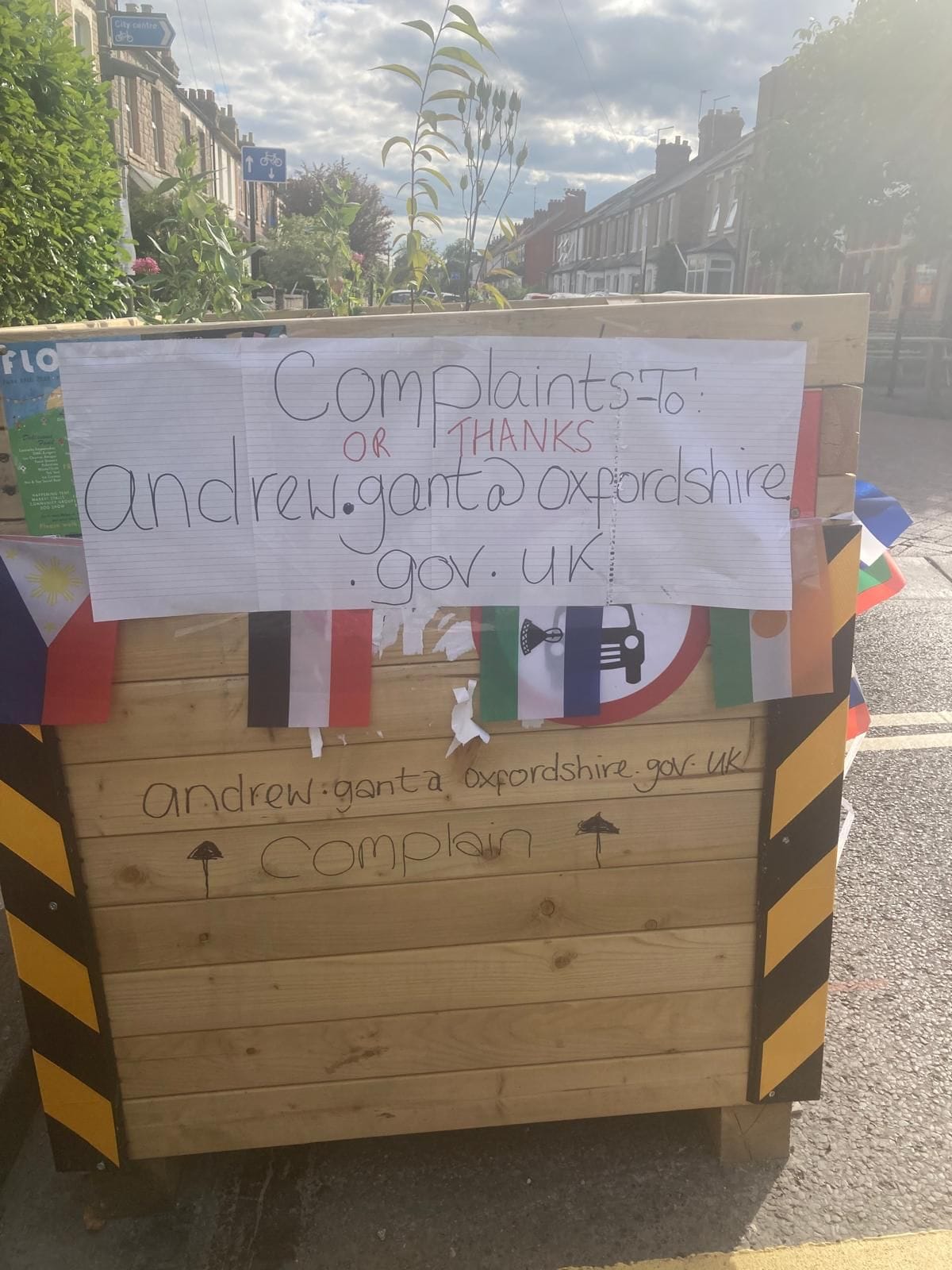
What would you say to people, and councils, from beyond Oxfordshire looking at what’s happening in the city?
One of the best parts of my job is talking to colleagues from other places, in the UK and abroad, and learning from each others’ experiences. It’s fascinating.
I would say, help us get this right. If you think we can help you, that’s great. And let’s talk about the bigger picture, about the direction of travel nationally and internationally. Let’s talk about getting people moving and how that can help the NHS, climate change and fuel security.
We have all got used to just helping ourselves to road space, as much as we want whenever we want, as if it was free, like breathing the air. Actually, it’s a public good. It’s finite, and it’s full. We’ve got to manage how we all use it, and the more we can share and learn with other places, the better.
Any final thoughts?
It’s a huge encouragement and support to know that there is a committed and principled body of support behind our vision, covering individuals in all political parties, activist groups, the voluntary sector, innovative businesses, and people who simply take the time to drop me a supportive email. I call it the coalition of the willing.
I am convinced that most people recognise the problem we are trying to fix, understand the need for a plan, and are willing to give us a chance, even if we legitimately disagree about some of the steps on the way.
I don’t think anybody thinks we can’t do better. No serious observer really thinks these are just the policies of one politician, or even one party or administration. We have a responsibility to work together and to take the opportunity the electorate has entrusted to us. We will do that. Help us make Oxfordshire a better place.
